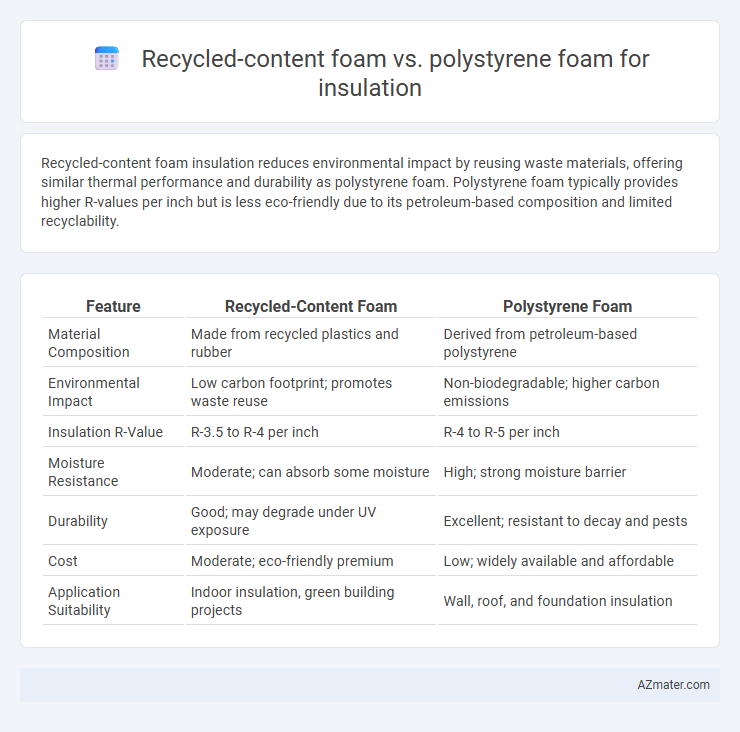Recycled-content foam insulation reduces environmental impact by reusing waste materials, offering similar thermal performance and durability as polystyrene foam. Polystyrene foam typically provides higher R-values per inch but is less eco-friendly due to its petroleum-based composition and limited recyclability.
Table of Comparison
| Feature | Recycled-Content Foam | Polystyrene Foam |
|---|---|---|
| Material Composition | Made from recycled plastics and rubber | Derived from petroleum-based polystyrene |
| Environmental Impact | Low carbon footprint; promotes waste reuse | Non-biodegradable; higher carbon emissions |
| Insulation R-Value | R-3.5 to R-4 per inch | R-4 to R-5 per inch |
| Moisture Resistance | Moderate; can absorb some moisture | High; strong moisture barrier |
| Durability | Good; may degrade under UV exposure | Excellent; resistant to decay and pests |
| Cost | Moderate; eco-friendly premium | Low; widely available and affordable |
| Application Suitability | Indoor insulation, green building projects | Wall, roof, and foundation insulation |
Introduction: Understanding Insulation Material Choices
Recycled-content foam insulation offers an environmentally friendly alternative to traditional polystyrene foam by incorporating post-consumer and industrial waste, reducing landfill impact and conserving resources. Polystyrene foam, widely used for its high R-value and moisture resistance, provides excellent thermal insulation but relies on petroleum-based materials, raising sustainability concerns. Evaluating these materials requires balancing performance metrics like thermal conductivity, durability, and environmental impact to make informed insulation choices.
What Is Recycled-Content Foam Insulation?
Recycled-content foam insulation is made from waste materials such as plastics, rubber, or other industrial by-products, repurposed to create eco-friendly insulation solutions with reduced environmental impact. It offers comparable thermal performance to traditional polystyrene foam, measured by R-value, but emphasizes sustainability through the reduction of raw material consumption and landfill waste. This insulation type supports green building certifications by lowering embodied carbon and enhancing energy efficiency in residential and commercial construction.
Overview of Polystyrene Foam Insulation
Polystyrene foam insulation, available in expanded (EPS) and extruded (XPS) forms, offers high thermal resistance with R-values typically ranging from 3.6 to 5 per inch, making it effective for reducing heat transfer in residential and commercial buildings. Its closed-cell structure provides moisture resistance, durability, and structural strength, often used in foundation walls, roofing, and under slabs. While polystyrene foam is widely favored for its energy efficiency and ease of installation, environmental concerns arise from its petroleum-based production and limited recycling options compared to recycled-content foam alternatives.
Thermal Performance: Comparing R-Values
Recycled-content foam insulation typically achieves R-values ranging from 3.5 to 6.5 per inch, offering competitive thermal resistance compared to traditional polystyrene foam, which generally provides R-values around 3.6 to 5 per inch. Closed-cell polystyrene foam exhibits higher R-values, approximately 5 per inch, due to its dense structure, while recycled-content foams may vary depending on binder and material sources. Selecting insulation based on precise R-values directly impacts energy efficiency and long-term thermal performance of building envelopes.
Environmental Impact and Sustainability
Recycled-content foam insulation reduces landfill waste and lowers greenhouse gas emissions by utilizing post-consumer or post-industrial materials, offering a sustainable alternative to conventional polystyrene foam. Polystyrene foam, while effective for thermal insulation, is derived from non-renewable petroleum resources and often presents challenges in recycling due to its chemical structure and contamination issues. Choosing recycled-content foam supports circular economy principles by minimizing raw material extraction and promoting material reuse, thereby enhancing the overall environmental profile of insulation products.
Energy Efficiency and Cost Considerations
Recycled-content foam insulation offers enhanced energy efficiency by reducing thermal bridging and providing superior R-values compared to traditional polystyrene foam, resulting in lower heating and cooling costs over time. Polystyrene foam, while initially more affordable, often lacks the environmental benefits and may exhibit reduced long-term performance due to potential off-gassing and lower recycled content. Choosing recycled-content foam supports sustainability goals and can lead to greater cost savings through increased durability and improved insulation effectiveness.
Health and Indoor Air Quality Factors
Recycled-content foam insulation offers significant advantages over traditional polystyrene foam by reducing the emission of volatile organic compounds (VOCs), thereby improving indoor air quality and minimizing respiratory irritants. Polystyrene foam often releases styrene and other hazardous chemicals, which can contribute to indoor air pollution and pose health risks such as headaches and asthma exacerbations. Choosing recycled-content foam supports healthier living environments by lowering harmful off-gassing while maintaining effective thermal insulation performance.
Moisture Resistance and Durability
Recycled-content foam insulation offers enhanced moisture resistance due to its closed-cell structure that minimizes water absorption, reducing risks of mold and degradation over time. Polystyrene foam, commonly available as extruded (XPS) or expanded (EPS), provides strong durability and moisture resistance, with XPS typically outperforming EPS in water absorption rates. When selecting insulation for long-term performance, recycled-content foam's sustainable properties combined with its moisture resilience make it a competitive alternative to conventional polystyrene options.
Installation Process and Versatility
Recycled-content foam insulation offers greater flexibility during installation, conforming easily to irregular surfaces and reducing gaps for enhanced thermal performance. Polystyrene foam, while rigid and requiring precise cutting, provides excellent structural support and is ideal for consistent thickness applications such as roofing and wall sheathing. The adaptability of recycled-content foam in both spray and board forms enables diverse usage across residential and commercial projects, compared to the more limited form options available for polystyrene foam.
Conclusion: Which Foam Insulation Is Better?
Recycled-content foam offers significant environmental benefits by utilizing post-consumer materials, reducing landfill waste, and lowering carbon footprints compared to traditional polystyrene foam. Polystyrene foam, while effective in providing thermal insulation with high R-values and moisture resistance, has a higher environmental impact due to its petroleum-based production and limited recyclability. Choosing recycled-content foam insulation is generally better for sustainability goals without compromising insulation performance.

Infographic: Recycled-content foam vs Polystyrene foam for Insulation
 azmater.com
azmater.com